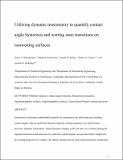Utilizing Dynamic Tensiometry to Quantify Contact Angle Hysteresis and Wetting State Transitions on Nonwetting Surfaces
Author(s)
Mabry, Joseph M.; Kleingartner, Justin Alan; Srinivasan, Siddarth; Cohen, Robert E; McKinley, Gareth H
DownloadUtilizing dynamic.pdf (1.962Mb)
PUBLISHER_POLICY
Publisher Policy
Article is made available in accordance with the publisher's policy and may be subject to US copyright law. Please refer to the publisher's site for terms of use.
Terms of use
Metadata
Show full item recordAbstract
Goniometric techniques traditionally quantify two parameters, the advancing and receding contact angles, that are useful for characterizing the wetting properties of a solid surface; however, dynamic tensiometry, which measures changes in the net force on a surface during the repeated immersion and emersion of a solid into a probe liquid, can provide further insight into the wetting properties of a surface. We detail a framework for analyzing tensiometric results that allows for the determination of wetting hysteresis, wetting state transitions, and characteristic topographical length scales on textured, nonwetting surfaces, in addition to the more traditional measurement of apparent advancing and receding contact angles. Fluorodecyl POSS, a low-surface-energy material, was blended with commercially available poly(methyl methacrylate) (PMMA) and then dip- or spray-coated onto glass substrates. These surfaces were probed with a variety of liquids to illustrate the effects of probe liquid surface tension, solid surface chemistry, and surface texture on the apparent contact angles and wetting hysteresis of nonwetting surfaces. Woven meshes were then used as model structured substrates to add a second, larger length scale for the surface texture. When immersed into a probe liquid, these spray-coated mesh surfaces can form a metastable, solid–liquid–air interface on the largest length scale of surface texture. The increasing hydrostatic pressure associated with progressively greater immersion depths disrupts this metastable, composite interface and forces penetration of the probe liquid into the mesh structure. This transition is marked by a sudden change in the wetting hysteresis, which can be systematically probed using spray-coated, woven meshes of varying wire radius and spacing. We also show that dynamic tensiometry can accurately and quantitatively characterize topographical length scales that are present on microtextured surfaces.
Date issued
2013-09Department
Massachusetts Institute of Technology. Department of Chemical Engineering; Massachusetts Institute of Technology. Department of Mechanical EngineeringJournal
Langmuir
Publisher
American Chemical Society (ACS)
Citation
Kleingartner, Justin A.; Srinivasan, Siddarth; Mabry, Joseph M.; Cohen, Robert E. and McKinley, Gareth H. “Utilizing Dynamic Tensiometry to Quantify Contact Angle Hysteresis and Wetting State Transitions on Nonwetting Surfaces.” Langmuir 29, no. 44 (November 5, 2013): 13396–13406 © 2013 American Chemical Society
Version: Author's final manuscript
ISSN
0743-7463
1520-5827